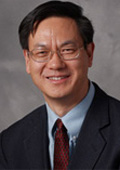Name: |
Zhonglin Wang |
Education: |
Ph.D. |
Positions: |
|
Academic title: |
Professor |
Postal Code: |
100190 |
Subject categories: |
Physics |
Mailing Address: |
No.11,Beiyitiao Zhongguancun Beijing,china |
E-mail: |
wangzl(AT)nanoctr.cn |
|

|
| Resume: |
| Dr. Wang received his Ph.D in Physics from Arizona State University in 1987. After a year of post-doctoral in the State University of New York at Stony Brook in 1988, Dr. Wang was awarded a Research Fellowship by the Cavendish Laboratory, University of Cambridge, England. He received a U.S. Department of Energy Research Fellowship at Oak Ridge National Laboratory in 1989, and one year later he was appointed as a Research Associate Professor by the University of Tennessee. In 1993, he moved to the National Institute of Standards and Technology (NIST) to set up the microscopy facility. He joined Georgia Tech in 1995. |
| Direction: |
| The July/August issue of the Science Watch published by the Institute of Scientific Information (ISI) lists the world's top 25 researchers and institutions in nanotechnology from 1992-2002. Z.L. Wang ranks number 5 internationally with 121 papers on the subject! His papers have been cited 2348 times placing him on the list of the top 25 most cited authors in the world. He has published 38% of the 6150 citations to Georgia Tech papersthat places Tech number 12 worldwide. The report has also highlighted Wang's research on nanobelt. Discovered the world s first piezoelectric nanospring, which has been reported by Business Week and e-Time. Discovered the nanobelt in 2001, which was considered to be a ground breaking work and was reported by over 20 media including USA Today, Science News, BBC News, and Frankfutter Allgemeine Zeitung. The discoverery of the nanobelt is being considered in the same category as the discovery of nanotubes. The paper on nanobelt was the most cited paper in chemistry in 2001-2003 (ISI, Science Watch). Discovered the perfect seamless nanoring of semiconducting and piezoelectric ZnO. Discovered the world s smallest balance, nanobalance, in 1999, which was selected as the breakthrough in nanotechnology by the America Physical Society in 2000. This discovery was covered by over 10 different media including Physics Today and People s Daily Discovered a novel technique for producing hydrogen from methane and water with the potential of using solar energy, which was covered by Business Week. |
| Achievements: |
| Dr. Wang has authored and co-authored four scientific reference and textbooks and over 350 journal articles, 40 review papers and book chapters, edited and co-edited ten volumes of books on nanotechnology, and held 8 patents and provisional patents. Dr. Wang is the world s top 25 most cited authors in nanotechnology from 1992-2002. His works have been cited for over 6000 times. He discovered the nanobelt in 2001, which was considered to be a ground breaking work and was reported by over 20 media including USA Today, Science News, BBC News, and Frankfutter Allgemeine Zeitung. The discoverery of the nanobelt is being considered in the same category as the discovery of nanotubes. In 1999, he discovered the world s smallest balance, nanobalance, in 1999, which was selected as the breakthrough in nanotechnology by the America Physical Society in 2000. This discovery was covered by over 10 different media including Physics Today and Science News. He has been elected to the European Academy of Science in 2002, has received the 2001 S.T. Li prize for Outstanding Contribution in Nanoscience and Nanotechnology, the 2000 Georgia Tech Faculty Research Award, the 1999 Burton Medal from Microscopy Society of America, 1998 US NSF CAREER award, and 1998 China-NSF Oversea Outstanding Young Scientists Award. He is a member of the editorial board of over 10 journals. |
| Article: |
1.Piezoelectric Nanogenerators Based on Zinc Oxide Nanowire Arrays, Z.L. Wang and J.H. Song Science, 14 April 2006: 242-246.
2.Direct-Current Nanogenerator Driven by Ultrasonic Waves,X.D. Wang, J.H. Song, J. Liu and Z.L. Wang Science, 316 (2007) 102-105.
3.Electrostatic Deflections and Electromechanical Resonances of Carbon Nanotubes,P. Poncharal, Z.L. Wang, D. Ugarte and W.A. De Heer, Science, 283 (1999) 1513-1516.
4.Shape-Controlled Synthesis of Colloidal Platinum Nanoparticles,T.S. Ahmadi, Z.L. Wang, T.C. Green, A. Henglein and M.A. El-Sayed, Science, 272 (1996) 1924-1926. |
| Commitment to research the situation: |
|
|
|
|